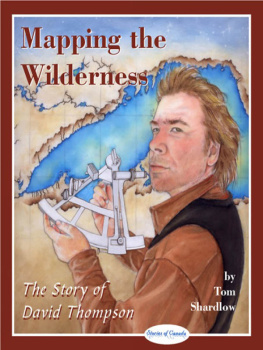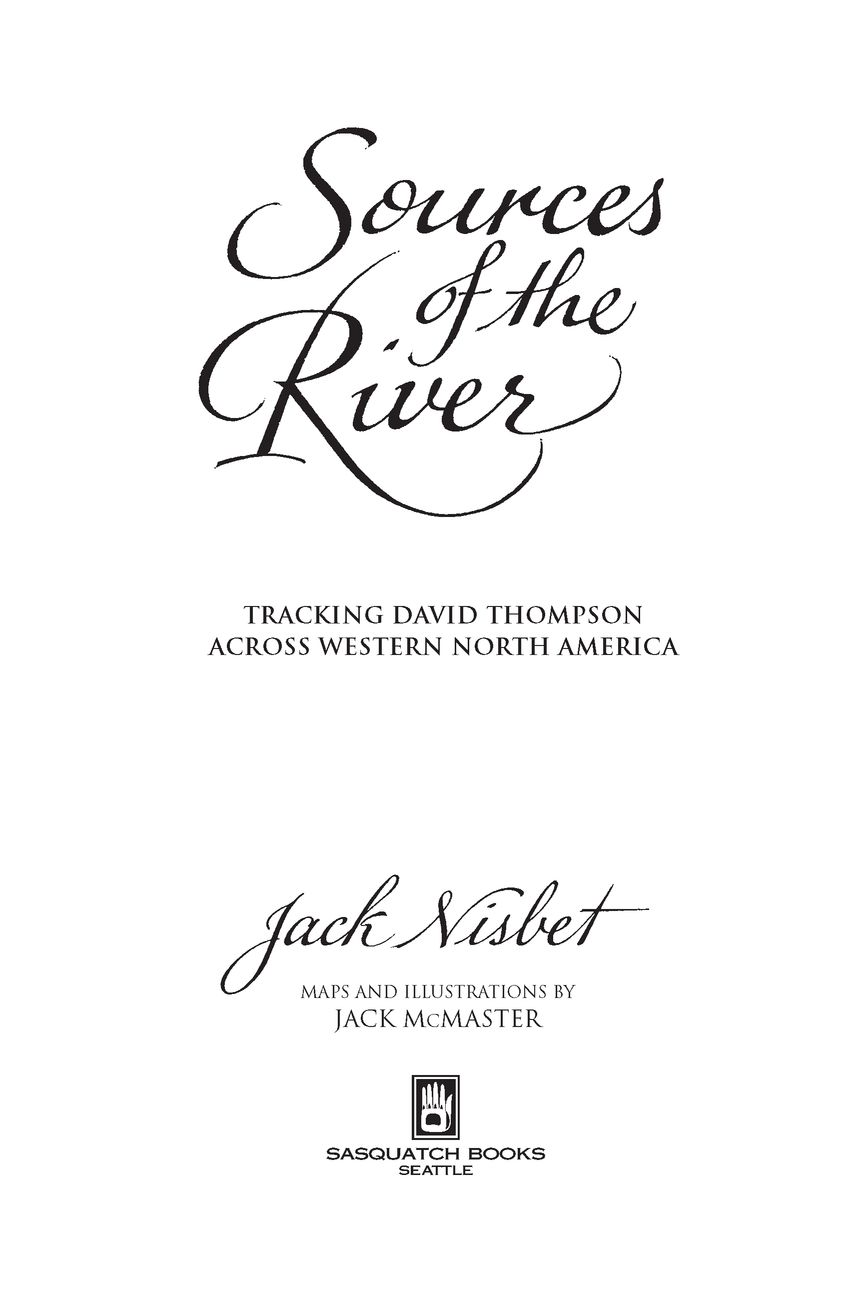Table of Contents
To J. D. and to Claire
FOREWORD TO THE 2007 EDITION
David Thompson traveled far and wide in mid- and northwestern North America. Even today, few people range over the continent as he did, from the northern boreal forest to the prairies and plains, from the Columbia Plateau to the Great Lakes Basin. Yet, whereas his contemporaries were heralded for their achievements in their lifetimes, he was not.
He was never offered a knighthood, as fellow fur trader Alexander Mackenzie, in 1793 the first European to cross the continent, had been in 1802. He was never made a governor of a territory, as Meriwether Lewis had been in 1807, a year after returning from his transcontinental expedition, or a superintendent of Indian Affairs, as Lewiss former commanding officer and fellow explorer William Clark had been in the same year. Unlike these men, he never had his portrait painted. The Welsh boy schooled in England before finding himself on the west shore of Hudson Bay in the midst of his teenage years was probably the best educated of this cohort of explorers, but his achievements were overlooked at least in part because he never managed to publish a book about his travels, as Mackenzie did in 1801, or catch the attention and travel under the auspices of a head of state, as Lewis and Clark had, at the behest of President Thomas Jefferson. Perhaps it was just as well, for Thompsons behavior as a cartographer, explorer, fur trader, and naturalist suggests that the mantle of public life would have sat awkwardly on him. Clearly, he preferred a book to a social gathering. And the book of nature was his favorite text.
Throughout the twentieth century, historians have tried to write Thompsons narrative of exploration and travel for him, working either from his twenty-eight years worth of field notebooks or from the four drafts of his narrative that fell incomplete at his death. In Sources of the River, Jack Nisbet succeeds by trying a different tack. He gives us a biographical sketch of the explorer at a human scale by setting his own perambulations and contemplations alongside Thompsons.
Thompson interested himself in the details of lifethe way, for example, that the tangled conifers on the shores of Lake Wollaston (which bestrides the watersheds of the Mackenzie and Churchill rivers in present-day northern Saskatchewan) could be loosened from the rock on which they clung, slid down into the water, and carried away by the wind, looking for all the world like substantial islets. So captivating did he find details that the production of a sustained narrative of all his travels and explorations kept bogging down in endless revision. The trees, not the forest, kept his focus. Thompson thought big by accruing details until they formed a whole, not by sweeping generalizations. And he was curious about geography and the natural world, less so about politics, business, and personal ambition. Nearly our sole fur trader whose business interest did not dominate his working life, he represents a rare breed. The Columbia River was a world of wonders for him, not principally a route. It has been said often that he lost the race to the Pacific to John Jacob Astors fur traders, but it was a race in which history, not he himself, entered him. He found the Columbia too engaging to treat it only as a thoroughfare.
Nisbet understands David Thompson. He gives us the man, the person, not the hero. Born in 1770 within a month of William Wordsworth, while fur trader and arctic explorer Samuel Hearne was struggling on the Seal River (in todays northern Manitoba) and Captain Cook was naming Botany Bay on Australias east coast (one bay south today of Sydneys harbor), Thompson grew up and was educated at a London charity school to be a reader. We can assume that, either before he left England or after reaching York Factory on Hudson Bay at the age of fourteen and taking up his duties as a writer under Hearnes charge, he read the works of Baron Lahontan and Louis Hennepin, the most widely read authors on North America in the first half of the eighteenth century, and of Jonathan Carver, whose Travels through the Interior Parts of North America (1778), which appeared in Thompsons London when he was eight years old, was the most commonly read narrative in the latter half of the eighteenth century about what would soon become the midwestern United States.
We know that Thompson copied for Hearne parts of his own journal of arctic exploration, which would appear posthumously as the Journey from Prince of Waless Fort (1795). Thompsons book knowledge apparently whetted his appetite to know more: more geography that awaited exploring and mapping, more native people to meet who could help him read the land, especially its watery veins, and more plants and animals than could ever be surmised by Comte de Buffon, whose theory that both animals and people in North America were feeble and degenerate forms of their European counterparts Jefferson would famously disparage in his Notes on the State of Virgina in 1784. Nisbet gives us that curious David Thompson better than anyone before him.
And he also does so in terms of the locale. Thompson charted so vast an area of the continent that Nisbets predecessors were always tempted to paint his achievements with a broad brush. But just as doing so does not suit Thompsons temperament, neither does it do his achievements justice. Despite his mobility, he was a man of place, one place at a time. He wrote as if he was always of the moment, not looking round the next bend of a river or trail, as Simon Fraser was in 1808 on the river that bears his name, or habitually negotiating to be handed from one native group to the next just to reach the Pacific, as one senses Alexander Mackenzie was from his Voyages from Montreal (1801).
And it is this particularity of time and place that Sources of the River captures so well. Nisbet does not pretend to intimately know all the watercourses paddled and mountain passes traversed by Thompson. Instead, he concentrates on the Columbia River and its tributaries on the Pacific Slope. More than Cartier with the St. Lawrence, Coronado with the Rio Grande, La Salle with the Mississippi, or even Mackenzie and Fraser with the rivers that bear their names and which they so disappointedly and quickly descended and ascended (both realizing that the watercourses would never further their purposes, for Mackenzie, of reaching the Pacific; for Fraser, of offering a navigable fur trade route), Thompsons name belongs to the Columbia. That the river is reduced today by what seems an infinite series of dams to what seems an infinite series of puddles and reservoirs, as one writer scornfully put it, makes all the more resonant Thompsons careful descriptions of its fitful, snarling reaches when it was a freely flowing deluge, rumbling out of the mountains, up north and then bending extraordinarily southward to course through the deserts of the Columbia Basin to the Cascades and the ocean. More than anyone else in written form, Thompson is the chronicler of that sinuous yet turbulent torrent, the dark arrow that was also the lifeblood and, with its salmon, the staff of life to so many peoples, and which took the explorer through a multilingual world of Interior and Coast Salish dialects, Chinook Jargon, Hawaiian, Cree, Iroquois, and French and English.
If, from our twenty-first century vantage point, assaulted as it is by the visual, David Thompson had a failing as an observer of his time and place, it is that his chronometer was his only paint brush; his maps his only sketchpads. Adding hue, tone, and shading to Thompsons life and times on the Pacific Slope, Jack Nisbet paints us the best portrait we have of David Thompson. As we come to mark the bicentennial of the explorers years on the Pacific Slope, this new edition of





